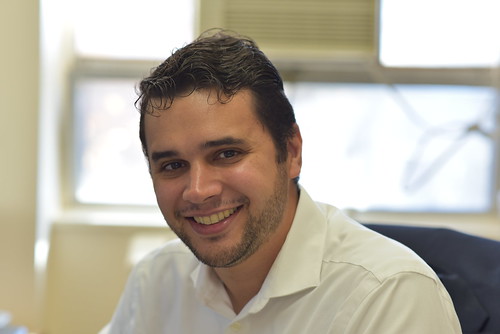This article originally appeared on CAHNR Newsroom.
Breno Fragomeni, assistant professor in the Department of Animal Science, conducts genetic research to enhance animal production, breeding and health.
“My current research is focused on animal genomics to improve selection and breeding decisions,” says Fragomeni. “Our goal is to find the right animals to improve the herd and be able to predict performance while the animals are very young.”
Some of his past projects include identifying heat tolerant boars to reduce heat stress complications and analyzing fish to select for disease resistance. Both projects were successful in improving animal health.
Fragomeni is currently working on a three-year multi-state project funded by the USDA designed to identify dairy bull performance by region.
“We calculate breeding values based on particular traits of the bull by examining genotype by environmental interaction,” he explains. “The best bull for New England dairy cows may not be the same as for California cows.”
The first challenge of the project is accessing data collected by dairy farmers throughout the United States. He is working with a colleague at the USDA Agricultural Research Service Animal Genomics and Improvement Laboratory well as the Council on Dairy Cattle Breeding (CDCB), an organization that that manages data related to genetic evaluations and genomic predictions for dairy cattle. The CDCB manages over 138 million phenotypic records for more than 3.5 million genotyped animals. Fragomeni is also collaborating with Francesco Tiezzi, research assistant professor at North Carolina State University.
The study will examine milk production, fat and protein content as well as lactation curves and weather date, as weather can affect milk production as dairy cows are stressed by high temperatures.
“We use information on females to learn about the bull and examine bull phenotypes, pedigree and genomic markers,” Fragomeni says. “We are interested in the sire of the cow. We have breeding values for evaluated traits to compare each bull to the national average.”
When the study is complete, Fragomeni and Tiezzi plan to assemble an online database where a farmer may enter a zip code and have access to the information on which bulls might best suit the herds in their region.
In another project currently in the initial stages, Fragomeni is collaborating with the International Working Dog Registry (IWDR) to examine genetic information for Labrador retrievers being raised to become service dogs for the organization Guiding Eyes for the Blind.

The IWDR trains people to collect the phenotype information and has collected data on 20,000 Labradors from several different countries. Fragomeni is currently examining data to determine genotypes. He searches for animals that do not have any of the most common health issues, such as hip and elbow dysplasia and skin problems, but the most important part of this project is finding behavioral traits that are essential for working dogs. “We are focusing on a single breed for now and hope to continue working with other breeds in the future,” he says.
“The IWDR tests and ranks animals in very specific scenarios where a dog might be affected by external stimulation,” Fragomeni explains. “They have more than fifty phenotype characteristics for behavior.”
“Behavior is very important for becoming a good working dog, and a group often spends quite a lot of time and resources training a dog that never graduates. Our idea is to not only improve the herd overall but identify puppies that have a higher chance of becoming a guide dog in the end.”
“I think it is important to note that we can actually breed animals for selected purposes without any pharmaceutical intervention, using naturally existing genetic variation within a population,” Fragomeni says. “I work with all livestock species. We can use the genetics to shape the animals for food, service and health. In production animals, if we are able to increase the quality and quantity of food while using fewer resources, that can create a lasting impact on the environment.”
People often ask Fragomeni about his work, envisioning him working outdoors with his subjects, but he says that animal geneticists spend their days studying data and statistics at a computer. Additionally, they may not see the results of their work for many years, until the second generation of their research population comes of age.



